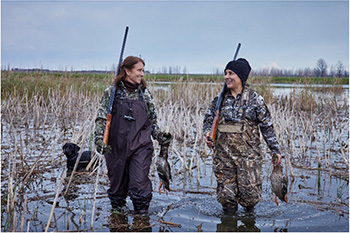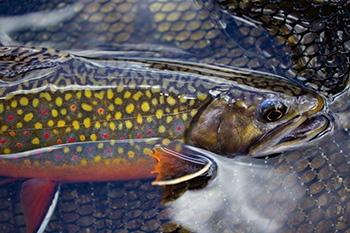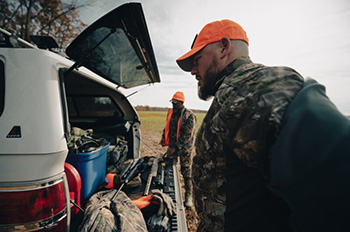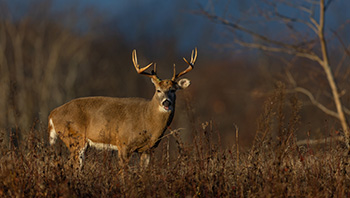Home → Fish & Wildlife → Wildlife → Support Wildlife → Federal Excise Tax Supports Fish and Wildlife Management
Federal Excise Tax Supports Fish and Wildlife Management

Photo courtesy of Northeast Association of Fish & Wildlife Agencies
Industry federal excise taxes have been crucial to American conservation since 1937, when pressure from conservation groups and the public helped pass the Federal Aid in Wildlife Restoration Act, known as Pittman-Robertson (PR), followed in 1950 by the Federal Aid in Sport Fish Restoration Act, known as Dingell-Johnson (DJ). Today, manufacturers' federal excise taxes on firearms, ammunition, fishing and boating equipment, and motorboat fuel tax provide roughly $1 billion in conservation and outdoor access funding to state fish and wildlife agencies annually.
For more than eighty years, Maine Department of Inland Fisheries and Wildlife has benefited from funds generated by manufacturer federal excise tax. The PR funds, collected through an 11% federal excise tax on firearms, ammunition, and archery equipment and a 10% excise tax on handguns, have been critical to conserving, monitoring, and managing wild mammals and birds throughout the state. These funds are also critical in habitat conservation with 69 Wildlife Management Areas covering more than 120,000 acres supported through federal excise taxes. Maine's wildlife management areas benefit hundreds of species directly providing habitat for species like white-tailed deer, moose, Canada lynx, New England cottontail, and hundreds of resident and migratory birds. These funds also provide opportunities for outdoor pursuits including hunting on Wildlife Management Areas and support for hunter education courses and target range construction and maintenance.

DJ funds, collected through the excise tax on fishing and boating equipment and motorboat fuel, are used to ensure clean water, healthy fish populations, and public access to Maine's waterways. For the full list of taxable fishing and boating items view the boating duties and taxes and fishing equipment sections of the Items Taxed to Support Wildlife & Sport Fish Restoration Funding in the United States (PDF) guide. Maine Department of Inland Fisheries and Wildlife biologists study, monitor, and manage sport fish species with the support of these funds including a brook trout and landlocked salmon tagging study on Mooselookmeguntic Lake and a brook trout study on the Roach River.
The partnership between the excise tax paying manufacturers, state fish and wildlife agencies that conserve wildlife and habitat, and the U.S. Fish and Wildlife Service's Office of Conservation Investment that administers these funds has been one of America's most effective tools for funding conservation. Here in Maine, up to 75% of the salaries and essential operating costs of our research, conservation efforts, and regional management staff time related to wild mammals and birds are supported through PR funds. Were it not for PR funds, we essentially would not have management programs for white-tailed deer, moose, black bear, furbearers, wild turkeys, waterfowl and upland game, nor wildlife disease monitoring, Christmas bird counts, habitat programs with landowners, or Wildlife Management Areas.

Photo courtesy of Northeast Association of Fish & Wildlife Agencies
Of the total federal manufacturers excise tax funds collected nationwide each year, each state receives a portion that is dependent on the land area of the state and the number of hunting and fishing licenses sold in the state. In 2024, Maine received $11.08 million in PR funds and nearly $3.92 million in DJ funding. How does this translate into wildlife and fisheries programs? First, the PR and DJ money must be spent on management efforts for wild mammals and birds and sport fish. Then, the federal money must be matched with 25% non-federal money, often from state hunting and fishing license dollars. This means that Maine contributed over $2.7 million in matching wildlife funds and over $980,000 in sport fish matching funds in 2024. For every $1.00 that Maine puts into management for wild mammals, wild birds, sport fish species, and outdoor access we can receive $3.00 more from PR and DJ funds through the federal excise tax.

These management efforts benefit species and current and future generations of Mainers ensuring healthy fish and wildlife populations and species habitat conservation. While not all Mainers participate in hunting, trapping, and fishing, they are important outdoor activities that connect people to our state's wild animals and wild landscapes. For many it is a lifestyle and gateway to the outdoors and a connection to nature. These pastimes often bring together family and friends and create lasting memories. Outdoor pursuits are a fantastic activity to get kids and adults outside and interacting with the environment. Studies show that time spent in nature positively affect health and well-being. This can be through lowering stress levels, increasing exercise, and even through the healthy lean protein harvested by hunting and fishing. Each year, Mainers sustainably harvest millions of pounds of protein from moose, black bear, white-tailer deer, waterfowl, and goose to feed their families and communities. In 2024 alone, over 42,000 deer were harvested in Maine. With an average meat yield of 58 pounds per deer that is over 2 million pounds of lean healthy protein on the plate.
In addition to the meals provided, hunting, trapping, and angling also provide important economic benefits throughout the state. Recreational fishing in Maine has an economic impact of over $320 million annually, supporting over 3,300 jobs; hunting in Maine has an economic impact of over $338 million and supports over 3,400 jobs. Outdoor pursuit related employment opportunities are shared across many sectors of the Maine economy. These income benefits are particularly important in rural or remote areas of the state, where the majority of hunting, trapping, and angling takes place.